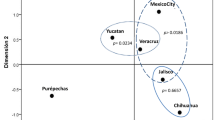Abstract
The use of bi-allelic markers such as retrotransposable element insertion polymorphisms or Innuls (for insertion/null) can overcome some limitations of short tandem repeat (STR) loci in typing forensic biological evidence. This study investigated the efficiency of the InnoTyper® 21 Innul markers in an urban admixed population sample in Rio de Janeiro (n = 40) and one highly compromised sample collected as evidence by the Rio de Janeiro police. No significant departures from Hardy-Weinberg equilibrium were detected after the Bonferroni correction (α′ ≈ 0.05/20, p < 0.0025), and no significant linkage disequilibrium was observed between markers. Assuming loci independence, the cumulative random match probability (RMP) was 2.3 × 10−8. A lower mean Fis value was obtained for this sample population compared with those of three North American populations (African-American, Southwest Hispanic, US Caucasian). Principal component analysis with the three North American populations and one from 21 East Asian population showed that African Americans segregated as an independent group while US Caucasian, Southwest Hispanic, East Asian, and Rio de Janeiro populations are in a single large heterogeneous group. Also, a full Innuls profile was produced from an evidence sample, despite the DNA being highly degraded. In conclusion, this system is a useful complement to standard STR kits.
Similar content being viewed by others
References
Butler JM, Shen Y, McCord BR (2003) The development of reduced size STR amplicons as tools for analysis of degraded DNA. J Forensic Sci 48:1054–1064 Paper ID JFS2003043_485
Kayser M, de Knijff P (2011) Improving human forensics through advances in genetics, genomics and molecular biology. Nat Rev Genet 12:179–192. doi:10.1038/nrg2952
Batzer MA, Deininger PL (2002) Alu repeats and human genomic diversity. Nat Rev Genet 3:370–379. doi:10.1038/nrg798
Gill P, Werrett DJ, Budowle B, Guerrieri R (2004) An assessment of whether SNPs will replace STRs in national DNA databases—joint considerations of the DNA working group of the European Network of Forensic Science Institutes (ENFSI) and the Scientific Working Group on DNA Analysis Methods (SWGDAM). Sci Justice 44:51–53. doi:10.1016/S1355-0306(04)71685-8
LaRue BL, Sinha SK, Montgomery AH, Thompson R, Klaskala L, Ge J, King J, Turnbough M, Budowle B (2012) INNULs: a novel design amplification strategy for retrotransposable elements for studying population variation. Hum Hered 74:27–35. doi:10.1159/000343050
Sudhir K, Carter A (2010) Method for genetic detection using interspersed genetic elements. US patent # 7,794,983
Feng Q, Moran JV, Kazazian HH Jr, Boeke JD (1996) Human L1 retrotransposon encodes a conserved endonuclease required for retrotransposition. Cell 87:905–916
Houck CM, Rinehart FP, Schmid CW (1979) A ubiquitous family of repeated DNA sequences in the human genome. J Mol Biol 132:289–306
Kazazian HH, Moran JV (1998) The impact of L1 retrotransposons on the human genome. Nat Genet 19:19–24. doi:10.1038/ng0598-19
Mamedov IZ, Shagina IA, Kurnikova MA, Novozhilov SN, Shagin DA, Lebedev YB (2010) A new set of markers for human identification based on 32 polymorphic Alu insertions. Eur J Hun Genet 18:808–814. doi:10.1038/ejhg.2010.22
Hughes-Stamm R, Ashton KJ, van Daal A (2011) Assessment of DNA degradation and the genotyping success of highly degraded samples. Int J Legal Med 125:341–348. doi:10.1007/s00414-010-0455-3
Batzer MA, Stoneking M, Alegria-Hartman M, Bazan H, Kass DH, Shaikh TH, Novick GE, Ioannou PA, Scheer WD, Herrera RJ (1994) African origin of human-specific polymorphic Alu insertions. Proc Natl Acad Sci U S A 91:12288–12292
Brown H, Thompson R, Murphy G, Peters D, LaRue B, Kiing J, Montgomery AH, Carroll M, Baus J, Sinha S, Wendt FR, Song B, Chakraborty R, Budowle B, Sinha SK (2017) Development and validation of a novel multiplexed DNA analysis system, InnoTyper®21. Forens Sci Int Genet 29:80–99. doi:10.1016/j.fsigen.2017.03.017
Budowle B, Monson KL, Chakrabort R (1996) Estimating minimum allele frequencies for DNA profile frequency estimates for PCR-based loci. Int J Legal Med 108:173–176
Chakraborty R (1992) Sample size requirements for addressing the population genetic issues of forensic use of DNA typing. Hum Biol 64:141–159
Oostdik K, Lenz K, Nye J, Schelling K, Yet D, Bruski S, Strong J, Buchanan C, Sutton J, Linner J, Frazier N, Young H, Matthies L, Sage A, Hahn J, Wells R, Williams N, Price M, Koehler J, Staples M, Swango KL, Hill C, Oyerly K, Duke W, Katzilierakis L, Ensenberger MG, Bourdeau JM, Sprecher CJ, Krenke B, Storts DR (2014) Developmental validation of the PowerPlex® fusion system for analysis of casework and reference samples: a 24-locus multiplex for new database standards. Forensic Sci Int Genet 12:69–76. doi:10.1016/j.fsigen.2014.04.013
Weir BS, Cockerham CC (1984) Estimating F-statistics for the analysis of population structure. Evolution 38:1358–1370. doi:10.1086/667904
Campbell CD, Eichler EE (2013) Properties and rates of germline mutations in humans. Trends Genet 29:575–584. doi:10.1016/j.tig.2013.04.005
van den Berge M, Wiskerke D, Gerretsen RRR, Tabak J, Sijen T (2016) DNA and RNA profiling of excavated human remains with varying postmortem intervals. Int J Legal Med 130:1471–1480. doi:10.1007/s00414-016-1438-9
Sinha S, Murphy G, Brown H, Montgomery A, Carrol M, Tabak J (2015) Retrotransposable elements: novel and sensitive DNA markers and their application in human identity. Forensic Sci Int Genet Supp Ser 5:e627–e629. doi:10.1016/j.fsigss.2015.10.005
Acknowledgments
This work was supported in part by research grants from FAPERJ, CNPq, CAPES, and INMETRO. Also, we would like to acknowledge the support of Innovagen and InnoGenomics.
Author information
Authors and Affiliations
Corresponding author
Ethics declarations
Conflict of interest
The authors declare that they have no conflict of interest.
Electronic supplementary material
ESM 1
(DOCX 84 kb).
Supplementary Table S1
(DOCX 27 kb).
Supplementary Table S2
(DOCX 39 kb).
Supplementary Table S3
(DOCX 16 kb).
Supplementary Figure S1
(DOCX 70 kb).
Supplementary Figure S2
(DOCX 714 kb).
Supplementary Figure S3
(DOCX 1094 kb).
Supplementary Figure S4
(DOCX 1005 kb).
Supplementary Figure S5
(DOCX 507 kb).
Supplementary Figure S6
(DOCX 47 kb).
Supplementary Figure S7
(DOCX 518 kb).
Rights and permissions
About this article
Cite this article
Moura-Neto, R.S., Mello, I.C.T., Silva, R. et al. Evaluation of InnoTyper® 21 in a sample of Rio de Janeiro population as an alternative forensic panel. Int J Legal Med 132, 149–151 (2018). https://doi.org/10.1007/s00414-017-1642-2
Received:
Accepted:
Published:
Issue Date:
DOI: https://doi.org/10.1007/s00414-017-1642-2




